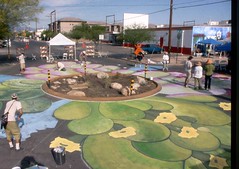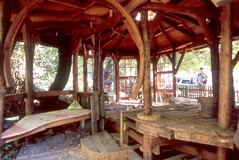City Repair began in Portland, Oregon with the idea that localization - of culture, of economy, of decision-making - is a necessary foundation of sustainability. By reclaiming urban spaces to create community-oriented places, we plant the seeds for greater neighborhood communication, empower our communities and nurture our local culture.
Intro to Placemaking
Placemaking is a multi-layered process within which citizens foster active, engaged relationships to the spaces which they inhabit, the landscapes of their lives, and shape those spaces in a way which creates a sense of communal stewardship and lived connection. This is most often accomplished through a creative reclamation of public space: projects which take the form of benches on street corners where neighbors can sit, rest and talk with each other, kiosks on sidewalks where neighbors can post information about local events, needs and resources and street paintings in the public right-of-way that demonstrate to all who pass through that this is a Place: inhabited, known and loved by its residents. In all instances, these projects are undertaken by local communities who come together to discuss what it is they want in their neighborhood – what elements are lacking in the public sphere and how the community can work together with the resources they have to create their own place.
 Placemaking touches upon deeper societal issues and contributes to participatory democracy. As the process of developing a community place proceeds; people develop deeper relationships and more energy to create together because they live together. Creating a common ground that transcends the differences among people powerfully addresses this isolation and creates an environment where people feel like they can do anything they set their collect minds to.
Placemaking touches upon deeper societal issues and contributes to participatory democracy. As the process of developing a community place proceeds; people develop deeper relationships and more energy to create together because they live together. Creating a common ground that transcends the differences among people powerfully addresses this isolation and creates an environment where people feel like they can do anything they set their collect minds to.Major Elements of Placemaking:
Natural Building: The essence of natural building lies in its inherent emphasis on environmental preservation and social sustainability. Natural building is a method of construction based in using minimally processed, natural materials that are available locally. The techniques for most natural building methods reflect the materials themselves in that they are simple, low-tech and ecologically sustainable. Natural building employs a sense of the human-scale and isn’t dependent on expensive, energy intensive, high-tech equipment. Natural building materials have low toxicity, are low-tech and local, making them great tools for teaching communities the synthesis of building principles in sustainability and social empowerment. Permaculture: Permaculture is the conscious design of sustainable human settlements. It is also about being local: shepherding the resources that enter a place; keeping them cycling within the “system,” be it backyard, neighborhood, or bioregion; and creating beneficial connections between each part. Community and a sense of place can only be created by the people who dwell together and who have real stake in creating a home.
Permaculture: Permaculture is the conscious design of sustainable human settlements. It is also about being local: shepherding the resources that enter a place; keeping them cycling within the “system,” be it backyard, neighborhood, or bioregion; and creating beneficial connections between each part. Community and a sense of place can only be created by the people who dwell together and who have real stake in creating a home.Public Art: Artwork in our neighborhoods can also create a strong sense of place, whether it is a mural, a sculpture, temporary art such as chalk drawings or functional art pieces like benches or lampposts. Public art presents an opportunity for a neighborhood to tell its history, express local culture and have a fun project for anyone to get involved.

No comments:
Post a Comment